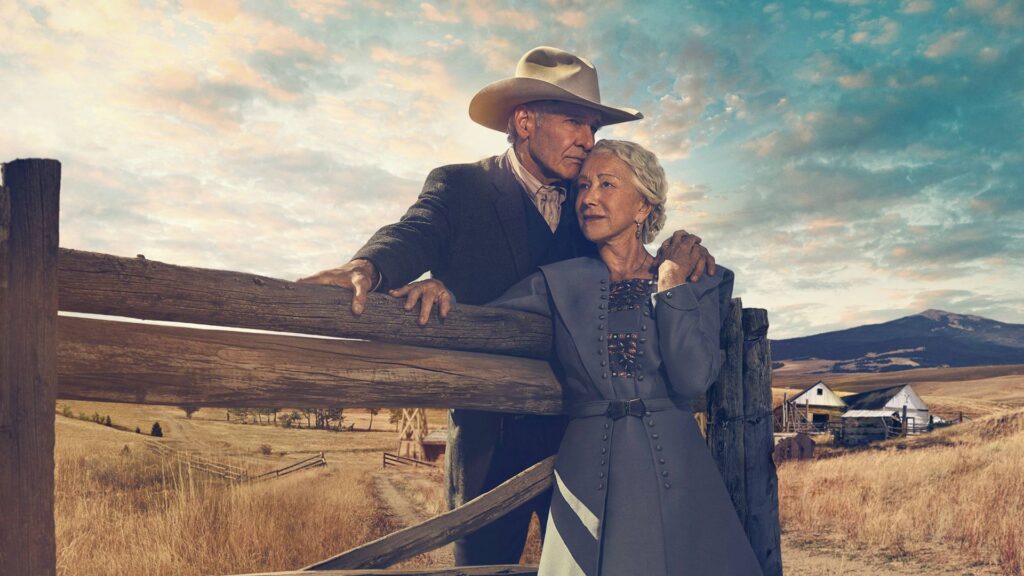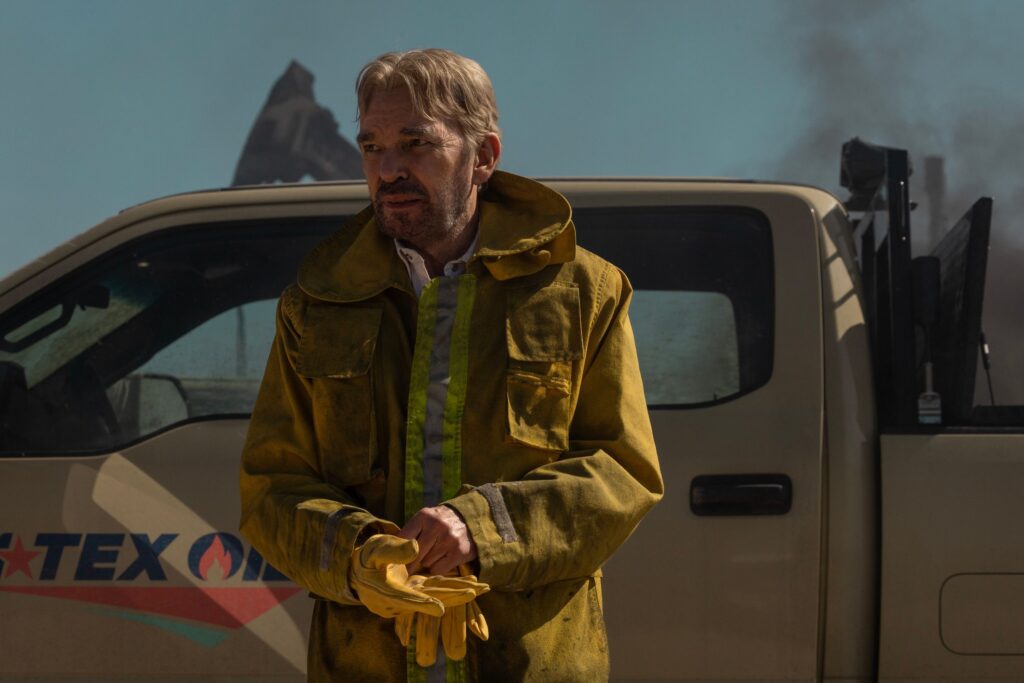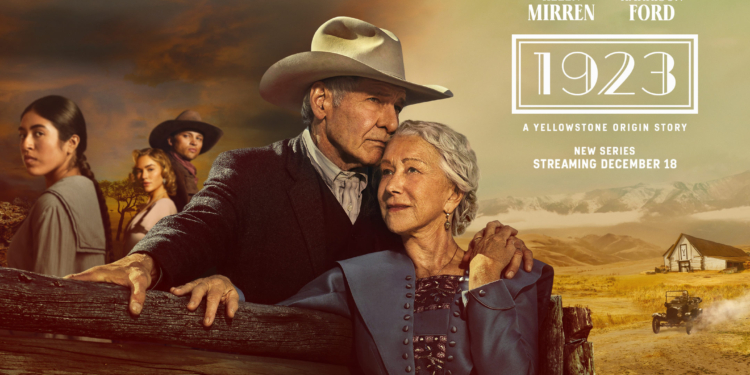Contents
- 1 1923: A Gritty Prelude to the Yellowstone Saga
- 1.1 Storyline and Themes
- 1.2 Cinematography
- 1.3 RelatedPosts
- 1.4 A Minecraft Movie Review: A Super-Fun Blocky Adventure That Nails the Sandbox Spirit
- 1.5 Death of a Unicorn Review: A Satirical Stab at Fantasy Horror
- 1.6 The Gentlemen (2024 TV Series) – A Stylish Crime Caper That’s More Than Just a Spin-Off
- 1.7 Acting and Performances
- 1.8 Narrative and Connection to Yellowstone
- 1.9 Strengths and Weaknesses
- 2 Land Man: A Gritty Tale of Modern Industry
- 3 Comparative Analysis of Taylor Sheridan’s TV Series 1923 & Land Man
- 4 Summing Up: Why Taylor Sheridan’s 1923 & Land Man Are Unmissable
Taylor Sheridan, renowned for his gripping narratives and masterful storytelling, has made a significant mark on television with series like Yellowstone and its prequels. In this review, we delve into two of his latest ventures: 1923, a historical drama set in the universe of Yellowstone, and Land Man, a contemporary exploration of the modern oil industry. Both series highlight Sheridan’s flair for dynamic characters and complex narratives, but they diverge in tone, focus, and execution.
1923: A Gritty Prelude to the Yellowstone Saga
Storyline and Themes
1923
is a gripping continuation of Sheridan’s Yellowstone universe, serving as a prequel to the Dutton family saga. Set during the early 20th century, it follows Jacob and Cara Dutton (played by Harrison Ford and Helen Mirren) as they navigate the trials of the Great Depression, Prohibition, and the expansion of the American West. The series immerses viewers in a world of hardship and resilience, exploring themes of survival, legacy, and the cost of protecting family and land.

The story intricately ties into Yellowstone by deepening our understanding of the Dutton family’s origins. It adds layers to the family’s struggle to hold onto their ranch, providing context for the conflicts seen in the flagship series. By portraying the Duttons’ early battles against external and internal threats, 1923 reinforces the generational stakes of their legacy.
Cinematography
Cinematographer Ben Richardson’s work in 1923 is nothing short of breathtaking. The sweeping vistas of Montana’s rugged landscapes become a character in themselves, underscoring the series’ themes of isolation and survival. The use of natural light and wide-angle shots creates an immersive visual experience, drawing viewers into the unforgiving beauty of the frontier.
The meticulous period detail further enhances the visual storytelling. From the authentic costumes to the intricate set designs, the world of 1923 feels lived-in and historically accurate. The cinematography captures both the grandeur and the grittiness of the era, offering a visceral sense of the challenges faced by the characters.
Acting and Performances
Harrison Ford and Helen Mirren deliver powerhouse performances as Jacob and Cara Dutton. Ford brings gravitas and rugged determination to his role, while Mirren’s portrayal of Cara is both fierce and tender. The chemistry between the two leads anchors the series, providing an emotional core that resonates throughout.
Supporting performances also shine, with standout roles from Brandon Sklenar as Spencer Dutton and Jerome Flynn as Banner Creighton. The ensemble cast brings depth and nuance to their characters, making the Dutton’s world feel rich and multidimensional.

Narrative and Connection to Yellowstone
One of 1923’s greatest strengths is its ability to balance its standalone story with its role as a prequel. The series delves into the Duttons’ early struggles without relying too heavily on references to #Yellowstone. However, for fans of the flagship series, the connections are deeply satisfying. The show lays the groundwork for key elements of the Dutton legacy, such as their fierce attachment to the ranch and their willingness to go to extreme lengths to protect it.
Sheridan’s writing excels in capturing the moral ambiguities of his characters. The Duttons are neither purely heroic nor villainous; their actions are driven by necessity and a fierce loyalty to family. This complexity mirrors the tone of Yellowstone, creating a cohesive narrative across the two series.
Strengths and Weaknesses
While 1923 is a triumph in many respects, it’s not without its flaws. The pacing can be uneven, with some episodes feeling overly drawn out. Additionally, the large ensemble cast means that certain storylines and characters receive less development than others. However, these shortcomings are minor compared to the series’ overall impact.
Watch the trailer for 1923 Season 1 below. Courtesy of Rotten Tomatoes.
Land Man: A Gritty Tale of Modern Industry
Storyline and Themes
In contrast to the historical focus of 1923, Land Man is a contemporary drama set in the world of the West Texas oil boom. Starring Billy Bob Thornton as a shrewd and morally complex oilman, the series explores the impact of the oil industry on individuals, families, and communities. The narrative weaves together themes of ambition, greed, and the environmental and social costs of industrial progress.

Unlike 1923, which leans heavily on its connection to Yellowstone, Land Man stands alone as a self-contained story. It’s a sharp critique of modern capitalism, delving into the ethical dilemmas faced by those who profit from natural resources. Sheridan’s writing is incisive, balancing the personal struggles of the characters with broader societal commentary.
Cinematography
The visual style of Land Man contrasts sharply with that of 1923. Where 1923 emphasizes the vast, untamed beauty of the frontier, Land Man captures the stark, industrial landscapes of West Texas. Cinematographer Robert MacLachlan uses a muted color palette to reflect the harsh realities of the oil industry. The gritty, almost documentary-style cinematography underscores the series’ themes of exploitation and resilience.
The visual juxtaposition of sprawling oil fields and small-town life highlights the socioeconomic divide created by the industry. The series’ use of light and shadow is particularly effective, symbolizing the moral gray areas inhabited by its characters.
Acting and Performances
Billy Bob Thornton delivers a magnetic performance as the lead character, whose charm and ruthlessness make him both compelling and unsettling. Thornton’s portrayal anchors the series, bringing depth and complexity to a character who could easily have been a one-dimensional antagonist.
The supporting cast, including Jon Hamm and Ali Larter, also deliver strong performances. Each character is well-drawn, with motivations and conflicts that feel authentic and relatable. The ensemble cast elevates the series, ensuring that the human cost of the oil industry remains at the forefront of the narrative.

Narrative and Themes
While Land Man lacks the direct connection to Sheridan’s broader universe seen in 1923, it compensates with a tightly focused and thematically rich narrative. The series doesn’t shy away from the harsh realities of its subject matter, offering a sobering look at the intersection of profit and ethics.
Sheridan’s writing excels in its exploration of moral ambiguity. The characters are deeply flawed, yet their choices are driven by circumstances that make their actions understandable, if not justifiable. This complexity adds depth to the story, making it more than just a critique of the oil industry.
Strengths and Weaknesses
One of Land Man’s strengths is its unflinching portrayal of its subject matter. The series doesn’t pull punches, offering a raw and honest look at the impact of the oil industry. However, this unrelenting focus on realism can make the series feel heavy at times, potentially alienating viewers looking for escapism.
Another potential drawback is the lack of broader context for some viewers. While the series is compelling on its own, it doesn’t have the built-in audience of a larger franchise like Yellowstone. This makes it more of a niche offering, though its quality ensures it’s worth seeking out.
Watch the trailer for Landman Season 1 below. Courtesy of Paramount Plus.
Comparative Analysis of Taylor Sheridan’s TV Series 1923 & Land Man
Storyline and Themes
Both 1923 and Land Man showcase Sheridan’s talent for crafting compelling narratives, but their focuses differ significantly. 1923 is a sweeping historical epic that explores themes of survival, legacy, and family. In contrast, Land Man is a contemporary drama that examines the personal and societal costs of modern industry.
While 1923 benefits from its connection to the Yellowstone universe, it’s also accessible to new viewers. Land Man, on the other hand, is a standalone series that relies on its sharp writing and strong performances to draw in audiences.
Cinematography
The visual styles of the two series reflect their differing tones and settings. 1923 is characterized by its expansive, cinematic shots of the American West, capturing both its beauty and harshness. Land Man employs a grittier, more intimate style, emphasizing the stark realities of the oil industry.
Both series use cinematography to enhance their storytelling, but 1923 leans more heavily on the grandeur of its setting, while Land Man focuses on the human and environmental impact of its subject matter.
Acting and Performances
The performances in both series are exceptional, with seasoned actors anchoring the narratives. Harrison Ford and Helen Mirren bring gravitas to 1923, while Billy Bob Thornton delivers a standout performance in Land Man. The supporting casts in both series are equally strong, adding depth and authenticity to their respective worlds.

Sheridan’s Vision
Taylor Sheridan’s storytelling is the common thread that ties these series together. His ability to craft morally complex characters and immersive worlds is evident in both 1923 and Land Man. However, the execution differs: 1923 feels like a natural extension of Sheridan’s Yellowstone saga, while Land Man represents a departure into new thematic territory.
Summing Up: Why Taylor Sheridan’s 1923 & Land Man Are Unmissable
Taylor Sheridan’s 1923 and Land Man are both compelling television series that showcase his strengths as a storyteller. While 1923 expands the Yellowstone universe with a rich historical narrative, Land Man offers a gritty, contemporary exploration of the oil industry. Both series excel in their own right, appealing to different audiences with their unique tones and themes.
For fans of Yellowstone, 1923 is a must-watch that deepens the saga’s mythology. Meanwhile, Land Man stands as a powerful standalone drama, proving that Sheridan’s storytelling prowess extends beyond the boundaries of his established universe. Together, these TV series highlight why Taylor Sheridan remains one of the most exciting voices in modern television.

Our Rating of Taylor Sheridan’s TV Series 1923 & Land Man
1923: 8.5/10
With its sweeping historical narrative, stunning cinematography, and powerful performances, 1923 is a must-watch for fans of Yellowstone and historical dramas alike. While some pacing issues and underdeveloped subplots detract slightly, the series remains a compelling addition to Sheridan’s oeuvre.
Land Man: 8/10
Land Man
delivers a gripping and unflinching exploration of the modern oil industry. Billy Bob Thornton’s standout performance, combined with the series’ gritty realism, makes it a thought-provoking and impactful watch. However, its heavy tone and niche subject matter may not appeal to all viewers.
This article has been written with the help of A.I. for topic research and formulation.








